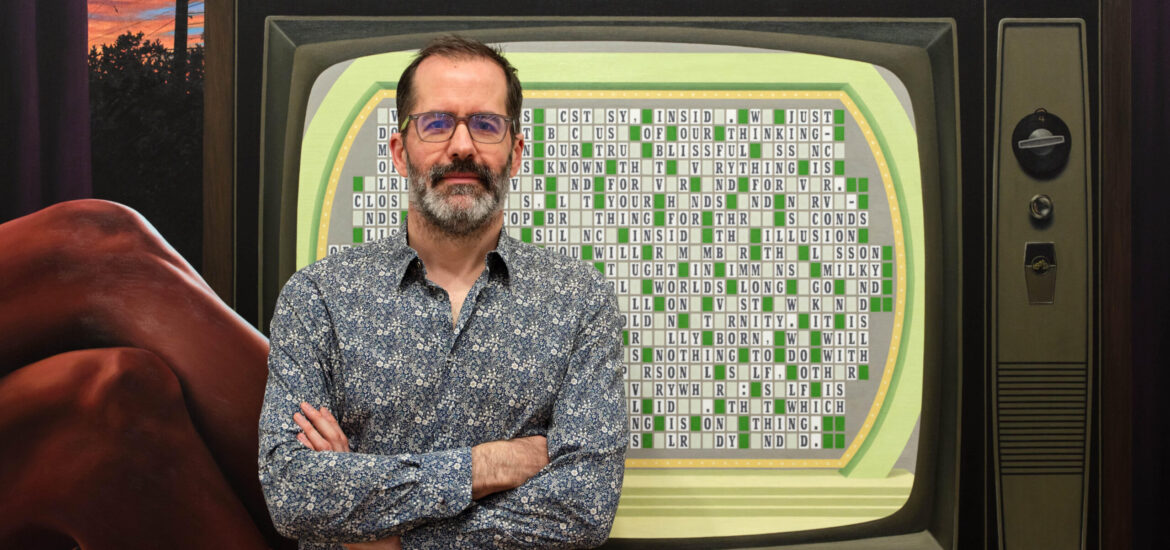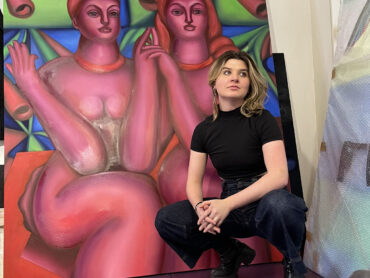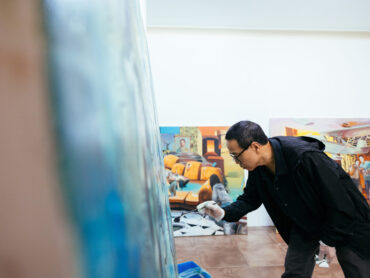Eric White- “Local Programming”
Written by Mario Tofano
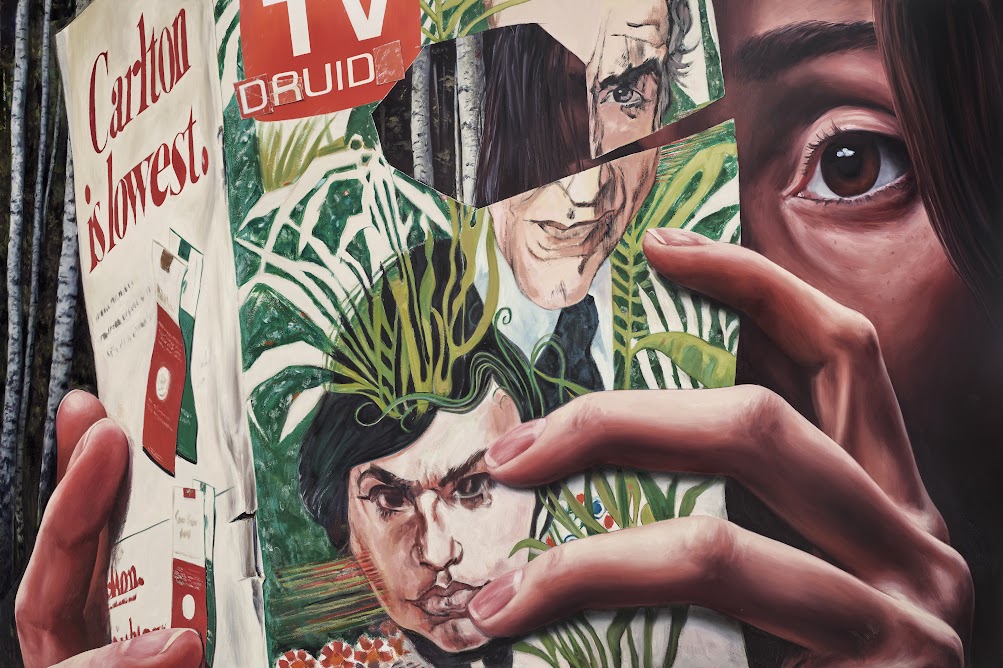
Druiding (Fantasy Island)
“The television screen has become the retina of the mind’s eye,” declares media prophet Professor Brian O’Blivion in David Cronenberg’s 1981 film Videodrome, both a diagnosis and an indictment of American media hyperconsumption. Central to Cronenberg’s frame throughout his film is the television set. A screen within a screen, no longer a mere prop or an inanimate object on the periphery of a room for families to gather around, but the central force around which all social life gravitates.
The television screen is also central in Local Programming, a new show from Los Angeles based artist Eric White, opening at New York’s GRIMM Gallery. In this series of twelve paintings, an enigmatic narrative unfolds involving an anonymous female figure (The Woman) who searches for and receives messages transmitted by television game shows and TV Guide magazines.
Throughout his career, White has interrogated various forms of mass media and popular culture. Over the last decade, he has integrated the ever-present screen into his work to explore ideas of participation and voyeurism. Envisioned here is a hallucinatory realism, an invented reality rendered with remarkable technical precision that is simultaneously marked by distortions in color, scale, and space. White’s paintings intend to keep us off balance in order to collapse any stable distinction between the real and the imagined. As with television, our perception is expanded at the moment it becomes compressed.
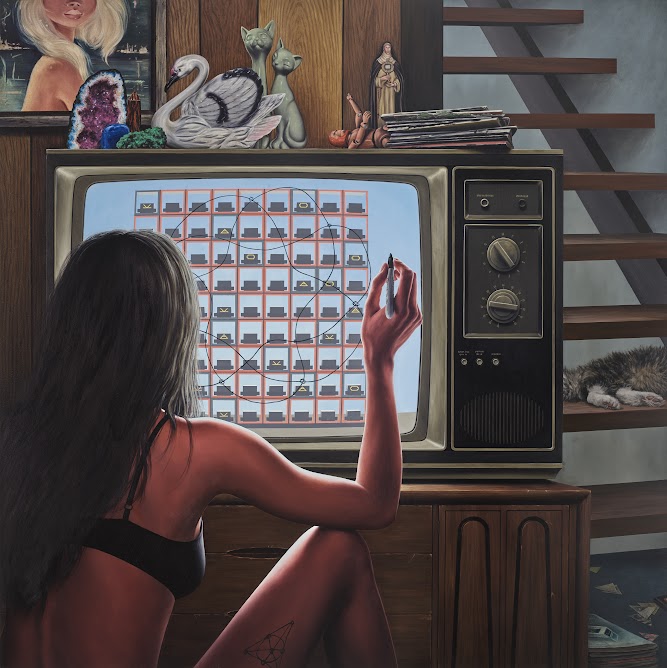
The Secret Square (HOLLYWOOD SQUARES) Photo: Courtesy of the Artist
Claustrophobia pervades the tightly-cropped compositions of The Woman while she watches The Hollywood Squares or The $10,000 Pyramid on one of her three tv sets. Yet these oppressively narrow wood paneled interiors are replaced by similarly tight exteriors that feature lush verdant fields, blue skies, and white barked birch trees. In other words, what appears to be The Woman’s confinement is actually a problem of our own limited perspective—we can’t see the whole picture, as it were. At the center of this work lies a classic epistemological crisis, namely, if perception is manipulable, as it is on screen, or if the source of information is unreliable, then how can we know anything we see to be true?
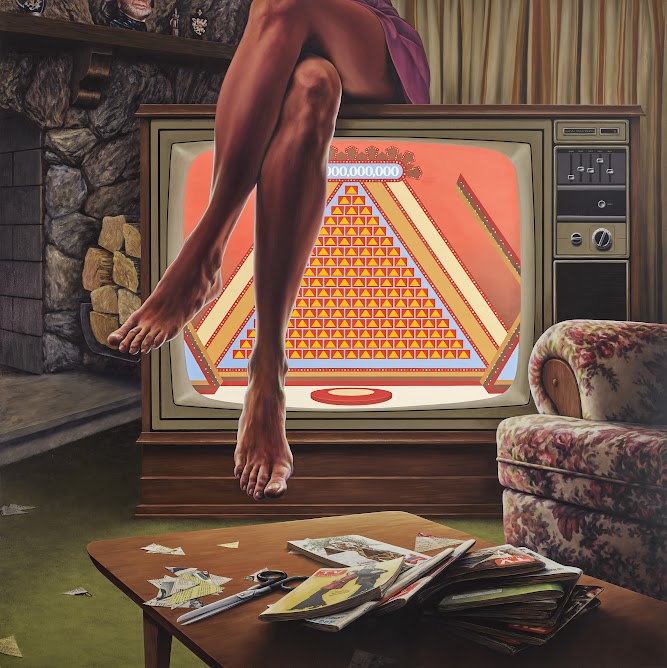
The Winner’s Circle (10,000 PYRAMID) Photo: Courtesy of the Artist
Whether The Woman suffers from boredom, paranoia, delusions of grandeur, or is experiencing spiritual awakening is an open question for which White has left few clues and little comfort. While her obsession with carving out the faces of Sofia Loren or The Mod Squad strike initially as perverse, the formal discipline with which she executes these perfectly cut triangles and geometric planes gestures toward a re-imagining of outdated materials. A creative act White achieves with the same hyperreal facsimiles of actual dated (and dated) TV Guide magazines.
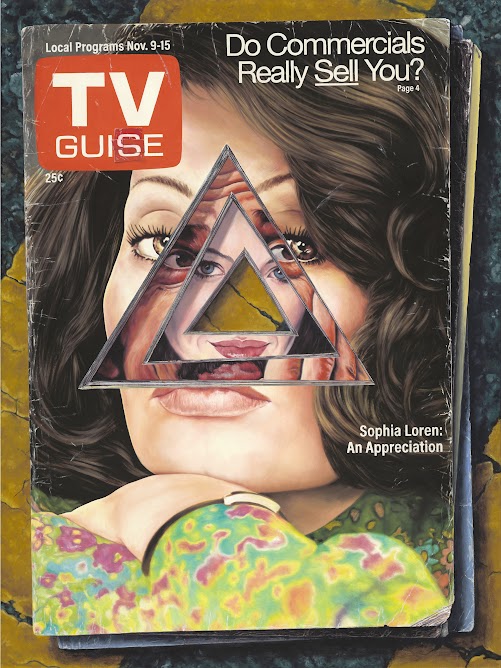
TV GUISE (Sophia Loren) Photo: Courtesy of the Artist
There is darkness and humor found in equal measure in White’s examination of mass media, celebrity obsession, social isolation, and creative authority. Unable to maintain an objective distance as a passive observer, the viewer is immersed into the frame, drawing affinities between disparate objects, discovering secrets in the magazine clippings, digging beneath the glossy surface of images.
In a standout work from the series, I’d Like To Buy A Vowel (Wheel of Fortune), White invites the viewer to actively watch tv. Positioned front and center in the composition is a brilliantly executed, deliriously bright green Wheel of Fortune puzzle board containing 844 squares–a feat of draftsmanship. Most of the consonants have been revealed but the vowels remain hidden, the puzzle unsolved. The thought of the immortal Pat Sajak and the inscrutable Vanna White waiting patiently to retire or expire as you slowly decipher the answer is itself tv gold. I have no intention of spoiling the experience but the extensive quotation comes from a letter Jack Kerouac wrote to his wife Edie in 1957 explaining his concept of the Golden Eternity. In what appears to finally be the clearest “message” transmitted by the cathode ray tube, White leaves us with a meditation inspired by the Buddhist Heart Sutra, Kerouac’s own variations on “emptiness is form and form is emptiness.”
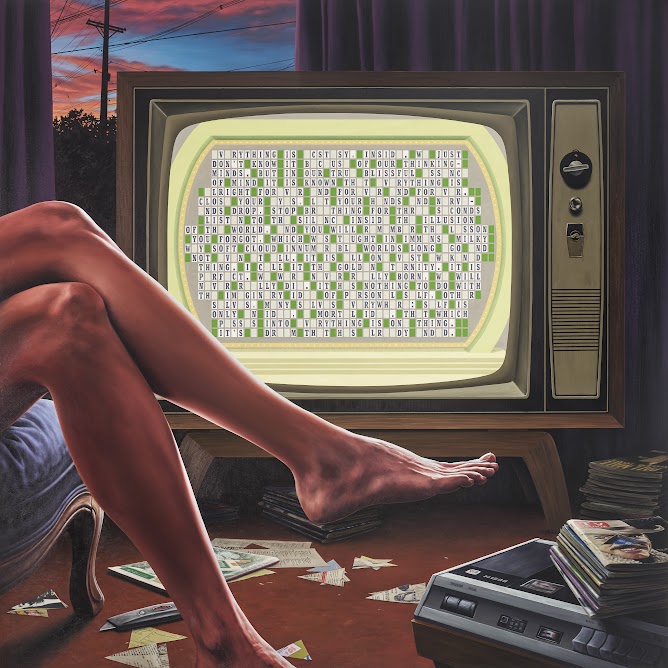
Id Like To Buy A Vowel (Wheel of Fortune) Photo: Courtesy of the Artist
White and I met in L.A. where we discussed cinema’s influence on his paintings, making demands of the audience, and nostalgia for the 70s.
MT- Your work has a cinematic quality to it. I’d describe them as uncanny film stills. I feel like I’ve been dropped into a scene of a familiar movie that doesn’t exist. How has your love of film influenced your painting?
EW- Well, it’s funny because I can still remember the first moment where I saw an image in a film and it struck me like a little epiphany. I was watching the George Stevens movie A Place in the Sun. It was a scene with Liz Taylor and Montgomery Cliff. And it was just this image of the two of them looking at each other. And I was high at the time. (laughs.) But I just saw this image and I decided to make a painting about it and it ended up being really—I thought at the time—really successful. That was the start of it. Using found imagery from film and recontextualizing it or taking elements and combining them in ways that change the context or kind of align it more with my vision, into this idea of alternate film realities.
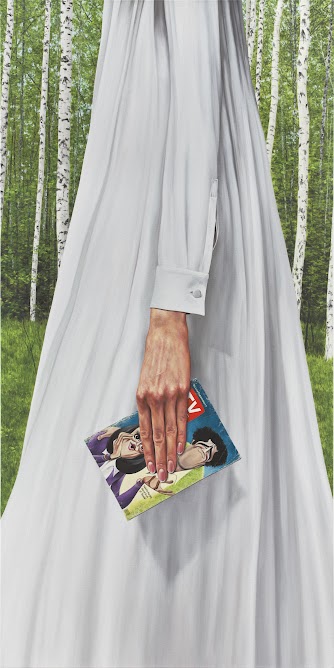
The Finite Path (Rhoda) Photo: Courtesy of the Artist
MT- You’ve talked about this idea of these alternative realities created by cinema as a kind of… what? An extension of our own conscious reality, which is itself an illusion?
EW- Something like that. It ultimately comes down to the idea of perception and the idea of erroneous perception. We tend to think the way we see the world is the way it actually is. We all live like that and it’s just not the case. There’s so much that exists beyond what we can perceive. So I just feel like I’m always trying to dig into that. And I’ve said it before too, I don’t think painting is a very effective way of getting at those ideas, but it’s the best that I’ve got.
MT- What is the narrative running through the new work?
EW- I’ve been tempted to say that this show is in a way an extension of the previous show I had in New York with Grimm in 2018. But that’s not completely accurate because in a weird way the 2018 show grew out of an idea that became this show. In preparing for that show in 2017 I had already had the insane amplified game show board idea in place. I was two months into the Hollywood Squares painting when Jorg, the owner of the gallery, came by for a studio visit. He said, “that’s a great painting but that’s another show.” I was shell-shocked at first but he was right. But that painting informed everything that came after it. So this show is the manifestation of the original idea come full circle. Both shows involve this mysterious female character whose identity is never really revealed. So it’s maybe the same woman, maybe it’s a different woman, and she is either suffering a mental breakdown or experiencing some sort of spiritual epiphany, or maybe it’s both at the same time. She’s convinced there are transmissions coming through to her from the television and it’s her job to decipher these codes that she is sure exist in the programming and in the TV Guide magazines.
MT- She’s compelled to cut into the magazines.
EW- Yeah, she starts literally chopping up the TV Guides and re-coding them and collaging the imagery on the covers. She makes these sacred objects out of these TV Guides.
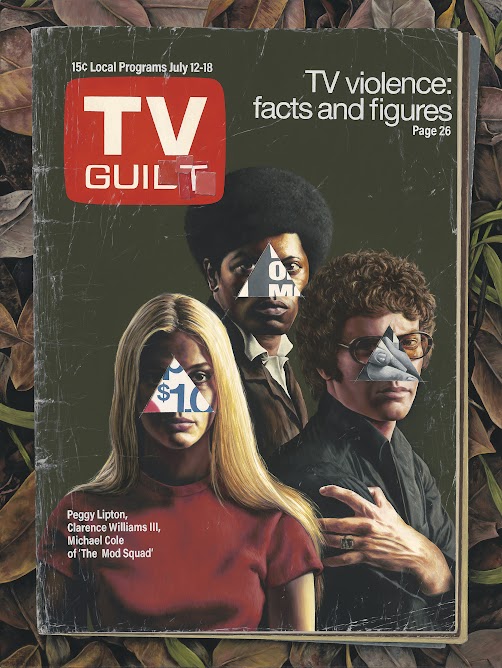
TV GUILT (Mod Squad) Photo: Courtesy of the Artist
MT- As if she’s creating meaning where there is no meaning.
EW- Well, to me, ultimately, I think it is about sort of finding meaning in the mundane and in the meaningless.
MT- Let’s talk about your work on I’d Like To Buy A Vowel.
EW- This was the idea that sparked my last two shows. Actually I looked back at my initial sketches and the concept for a massive Wheel of Fortune board is 12 years old. When I started work on the Hollywood Squares board back in 2017 it was because it seemed less daunting than the Wheel of Fortune board with all that fucking text. (laughs.) This piece for me is the funniest, the most coherent, and conceptually it works the best I think. But on a practical level making that painting was such a nightmare. I had so many technical issues with that, but I’m really happy with the way it came out. I just like how obnoxious it is. Don’t they say that the average painting is viewed for like 2.3 seconds or something?
MT- It’s demanding. You’ve placed a series of demands on your audience and they’ve got to spend time with it.
EW- Or they dismiss it entirely and walk away. (laughs.)
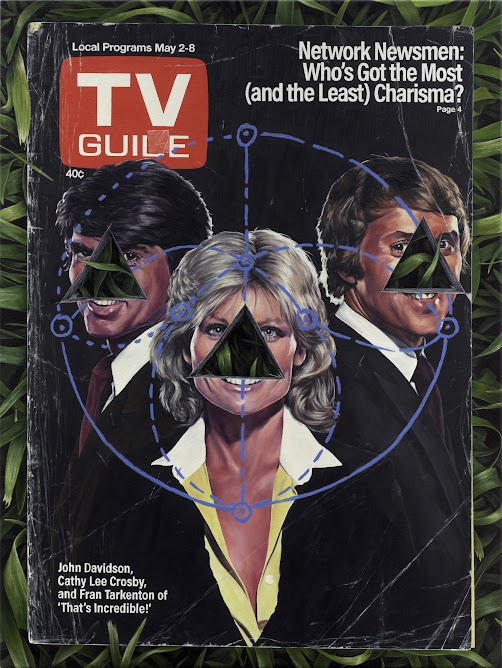
TV GUILE (That’s Incredible) Photo: Courtesy of the Artist
MT- These are funny images. There is a real dark and dry sense of humor to these paintings.
EW- I hope so. Also I hope they are funny after looking at them for longer than a minute. I don’t like jokey art, punchline art. I hope there is something that keeps revealing itself.
MT- There is a sense that the longer you spend looking, the puzzle will be revealed. But you’re kind of messing with the viewer too, right?
EW- That makes me think of the Baldessari quote: “It’s the artist’s job to fuck with the viewer.” I think I was already doing it before I read that but it made me so happy to read. He’s someone with so much humor in his work and he’s just a genius— I love that guy.
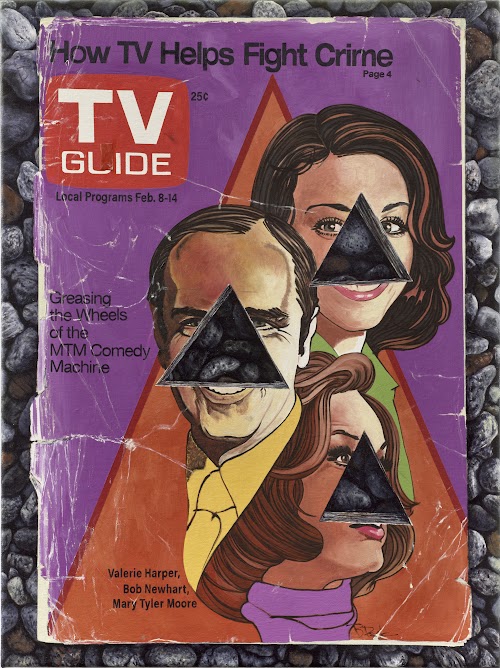
TV GLIDE (MTM) Photo: Courtesy of the Artist
MT- How else do you “fuck with the viewer”?
EW- That comes back to perception. The living spaces are all impossible. The perspective is all wrong. The rooms couldn’t actually exist like that. The game shows are impossibly amplified but also they’re devoid of people: no contestants, no host. Then there’s the trompe l’oeil technique with the magazine covers, but the scale is obviously all wrong. The screens are exaggerated and the covers are blown out of proportion. And a tv screen dead center is a compositional no-no. It shouldn’t work visually, but I like the boldness of it.
MT- Why did you obscure the faces in these works?
EW- I like to think of it in terms of the legacy of the painted portrait. From an art historical context, the idea of the portrait is of a human being. But here instead it’s a portrait of this magazine. That it’s a commercial magazine is funny to me. And then I’m adding the layer of her obscuring the face.
MT- Defiling it in some ways.
EW- Yeah, defiling it. Debasing the portrait. There’s a violence to it which I didn’t mean as a violent act, but it is.
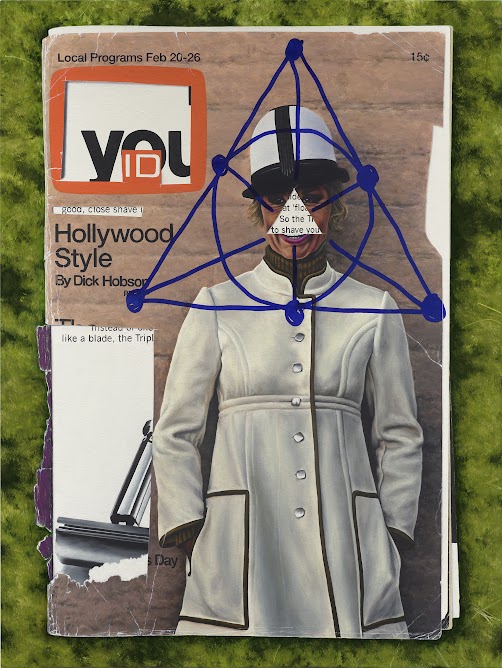
TV ID (Doris Day) Photo: Courtesy of the Artist
MT- There is something both unsettling and intriguing in the way you contrast the realistically rendered figure of The Woman with boldly-colored, flat, graphic game show boards. Why have you chosen to include this graphic element in your work?
EW- I’ve always been into the contrast between rendered and graphic imagery, and it’s been present in my work from the very beginning. It creates a compelling visual tension, and I enjoy the process as well. There is something satisfying about painting a razor-sharp edge, as well as a highly rendered form. So it’s definitely appealing from an aesthetic standpoint. Peter Blake was probably the initial inspiration. I’m thinking of his famous early self portrait, and On The Balcony. Conceptually the precise, ultra-graphic geometry is meant to represent the idealized perfection of a transmission emanating from a divine source. It’s also garish and otherworldly, especially in contrast to the rendered elements.
MT- Why have you set these works in the 1970s?
EW- It’s likely a matter of personal resonance and nostalgia. There is something to the brown-ness, the warmth, the simplicity. And even as that decade was incredibly formative for me there was and is something about it that depressed me. The show deals with television from a nostalgic perspective, “twas a far simpler time.” I think people seek comfort in nostalgia, comfort in the relics of the old. But it also speaks to our current screen-attention dilemma and manic obsession with and consumption of entertainment in all its forms.
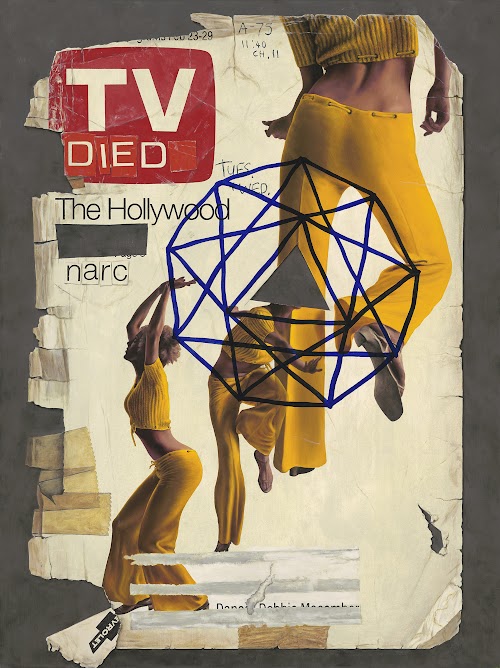
TV DIED (Hollywood Dancer) Photo: Courtesy of the Artist
MT- In an era of media saturation where we are inundated by images, reels, and we carry an insatiable appetite for streaming content, what can painting still teach us about searching for and discovering meaning?
EW- I don’t know, I don’t necessarily think painting is more meaningful than other forms of media or modes of information consumption. It’s all so subjective. I’m a ‘physical media’ fetishist and obsessively collect records, films and books. In our increasingly digital and virtual and artificial world, actual objects are becoming more important, almost sacred. Handmade paintings are precious. It can be such a powerful experience to stand in front of a painting. Unfortunately, only a handful of people will ever see them in person, which is pretty depressing. Even a great photograph of the work is still an approximation of the actual thing and will always lose a generation of fidelity. And, of course, the majority of people will see them on their phones. But whether you’re viewing it in person or as an image printed or on any machine, it still exists as a singular image. No matter how you slice it, a painting only exists in the present moment of the viewer’s experience, and there is a certain power in that.
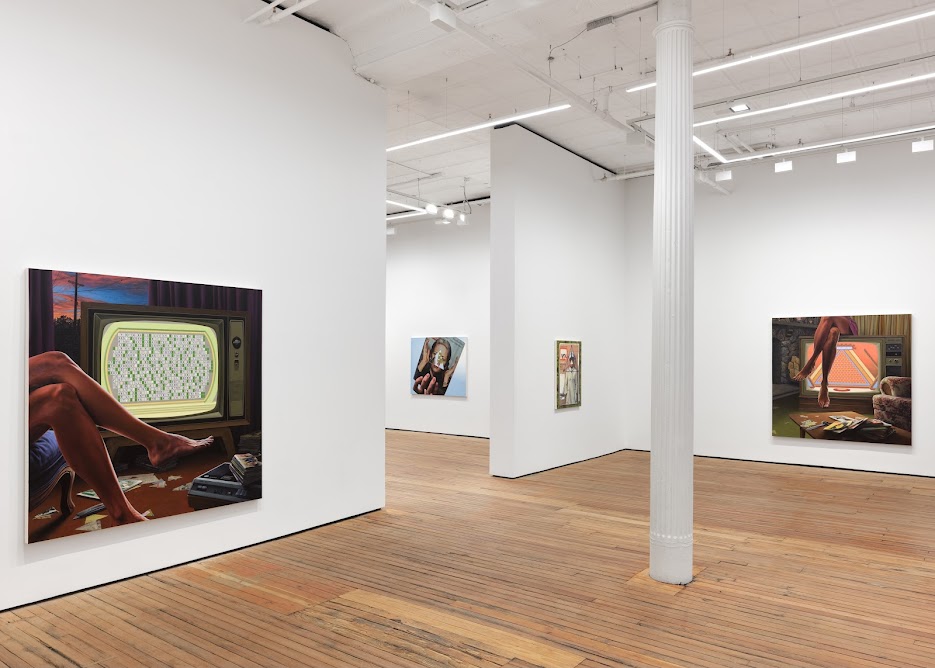
Installation view Local Programming, 2024_GRIMM NY Photo: Courtesy of the Artist
Local Programming is on view at GRIMM Gallery, NYC, from February 23 to March 30, 2024
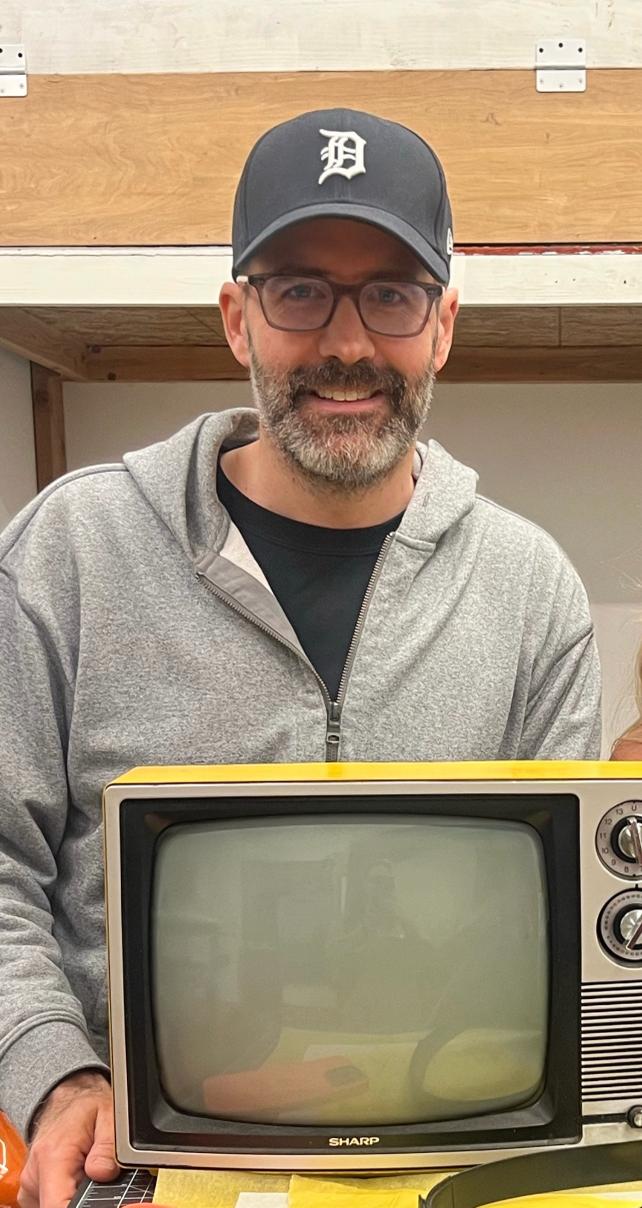
Eric White Photo: Courtesy Portray Magazine
